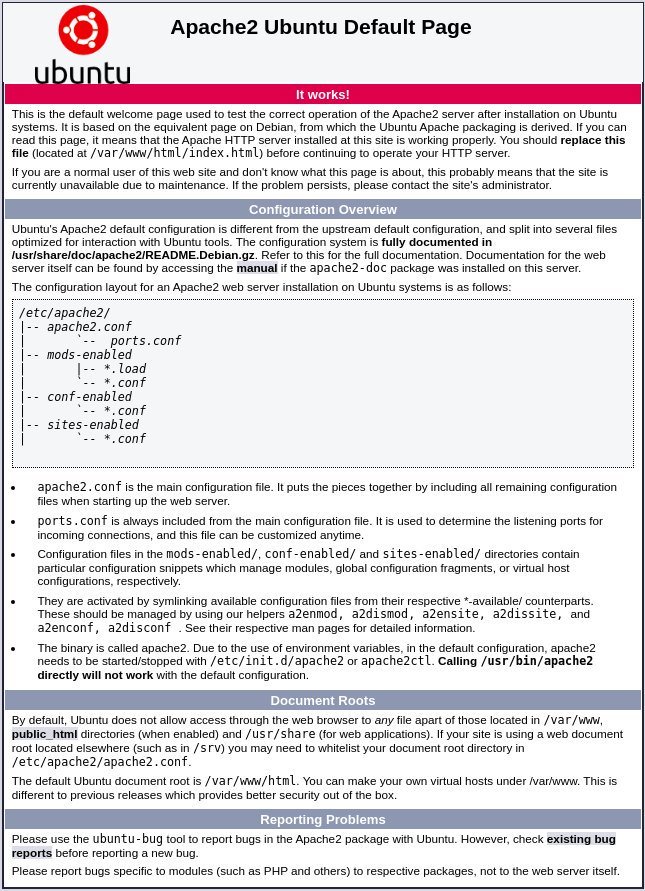How to install Apache on Ubuntu 20.04
Article Directory
-
- Prerequisites
- Two, install Apache
-
- Open HTTP and HTTPS ports
- Fourth, verify the Apache installation
- Five, set up a virtual host
- Six, summary


Apache is one of the most popular web servers in the world. It is an open source and cross-platform HTTP server, which hosts a large number of websites on the Internet. Apache provides a lot of powerful functions, and can extend other modules.
This article describes how to install and manage Apache web server on Ubuntu 20.04.
1. Prerequisites##
Before starting this guide, make sure you are logged in as a sudo user.
Two, install Apache
Apache is included in the default Ubuntu software source.
Installation is very straightforward. In Ubuntu and Debian systems, Apache packages and services are called apache2.
Run the following command to update the package index and install Apache:
sudo apt update
sudo apt install apache2
When the installation process is complete, the Apache service will be automatically started.
You can verify that Apache is running by entering the following command:
sudo systemctl status apache2
The output will tell you that the service is running and started on boot.
● apache2.service - The Apache HTTP Server
Loaded:loaded(/lib/systemd/system/apache2.service; enabled; vendor preset: enabled)
Active:active(running) since Sat 2020-05-0919:28:40 UTC; 36min ago
...
That's it, you have successfully installed Apache on your Ubuntu 20.04, and you can start using it.
3. Open HTTP and HTTPS ports##
Apache is listening on ports 80 (HTTP) and 443 (HTTPS). You need to open those ports in the firewall so that the web server is accessible from the Internet.
Assuming you are using UFW, you can configure it by enabling Apache Full, which includes rules for these two ports:
sudo ufw allow 'Apache Full'
Verify changes:
sudo ufw status
The output is as follows:
Status: active
To Action From
- - - - - - - - - - - - 22 /tcp ALLOW Anywhere
Apache Full ALLOW Anywhere
22 /tcp(v6) ALLOW Anywhere(v6)
Apache Full(v6) ALLOW Anywhere(v6)
Fourth, verify the Apache installation##
To verify that everything is working smoothly, open your browser and enter the server IP address http://YOUR_IP_OR_DOMAIN/, you can see the default Ubuntu 20.04 Apache welcome page, like the following:

This page contains some basic information about Apache configuration files, help scripts, and folder locations.
Five, set up a virtual host##
A virtual host is an Apache configuration command that allows you to run multiple websites on a server. A typical example, a virtual host describes a website.
Apache starts a virtual host by default. All domain names point to the server IP address, matching the default virtual host. If you only host a simple website, you need to upload the website content to /var/www/html, and edit the virtual host configuration, /etc/apache2/sites-enabled/000-default.conf file.
If you want to host more websites, you need to create a virtual host configuration for each website. In this section, we will set up a website for a domain name "example.com". You may need to replace "example.com" with your own domain name.
The first step is to create a root directory folder, where the website files of the domain name will be stored and respond to user requests. Run the following command to create this folder:
sudo mkdir -p /var/www/example.com
For testing purposes, create an index.html file in the root folder of the domain name:
<! DOCTYPE html><html lang="en" dir="ltr"><head><meta charset="utf-8"><title>Welcome to example.com</title></head><body><h1>Success! example.com home page!</h1></body></html>
When you are done, save and close the file.
To avoid permission problems, the user who modifies the root folder of the domain name belongs to the apache user (www-data):
sudo chown -R www-data:/var/www/example.com
The next step is to create a virtual host configuration for the domain name "example.com". The best practice is to store each virtual host configuration as a separate file.
Apache virtual host configuration [file storage] (https://cloud.tencent.com/product/cfs?from=10680) is in the /etc/apache2/sites-available directory. Standard naming uses a domain name to name the configuration file.
Open your text editor and create the following file /etc/apache2/sites-available/example.com.conf:
< VirtualHost *:80>
ServerName example.com
ServerAlias www.example.com
ServerAdmin [email protected]
DocumentRoot /var/www/example.com/public_html
< Directory /var/www/example.com/public_html>
Options -Indexes +FollowSymLinks
AllowOverride All
< /Directory>
ErrorLog ${APACHE_LOG_DIR}/example.com-error.log
CustomLog ${APACHE_LOG_DIR}/example.com-access.log combined
< /VirtualHost>
Apache will not read the configuration files in the /etc/apache2/sites-available folder unless they are linked to the /etc/apache2/sites-enabled folder.
To activate the virtual host configuration, create a link using a2ensite:
sudo a2ensite example.com
Test the configuration file for any syntax errors:
sudo apachectl configtest
If there are no errors, you will see the following output:
Syntax OK
Restart the Apache service to make the changes take effect:
sudo systemctl restart apache2
Finally, to verify that everything works as expected, open http://example.com in your browser, and you will see a picture similar to the following:

Six, summary##
We show you how to install Apache on Ubuntu 20.04. You are now ready to deploy your application and use Apache as a website or proxy server.
Original: https://linuxize.com/post/how-to-install-apache-on-ubuntu-20-04/
Copyright notice: This work uses Creative Commons attribution-Share 4 in the same way.0 International license agreement for licensing.

If you have any questions, please contact us in the following ways:
WeChat: sn0wdr1am86

WeChat group: add the above WeChat, remark the WeChat group
QQ: 3217680847

QQ Group: 82695646


Recommended Posts